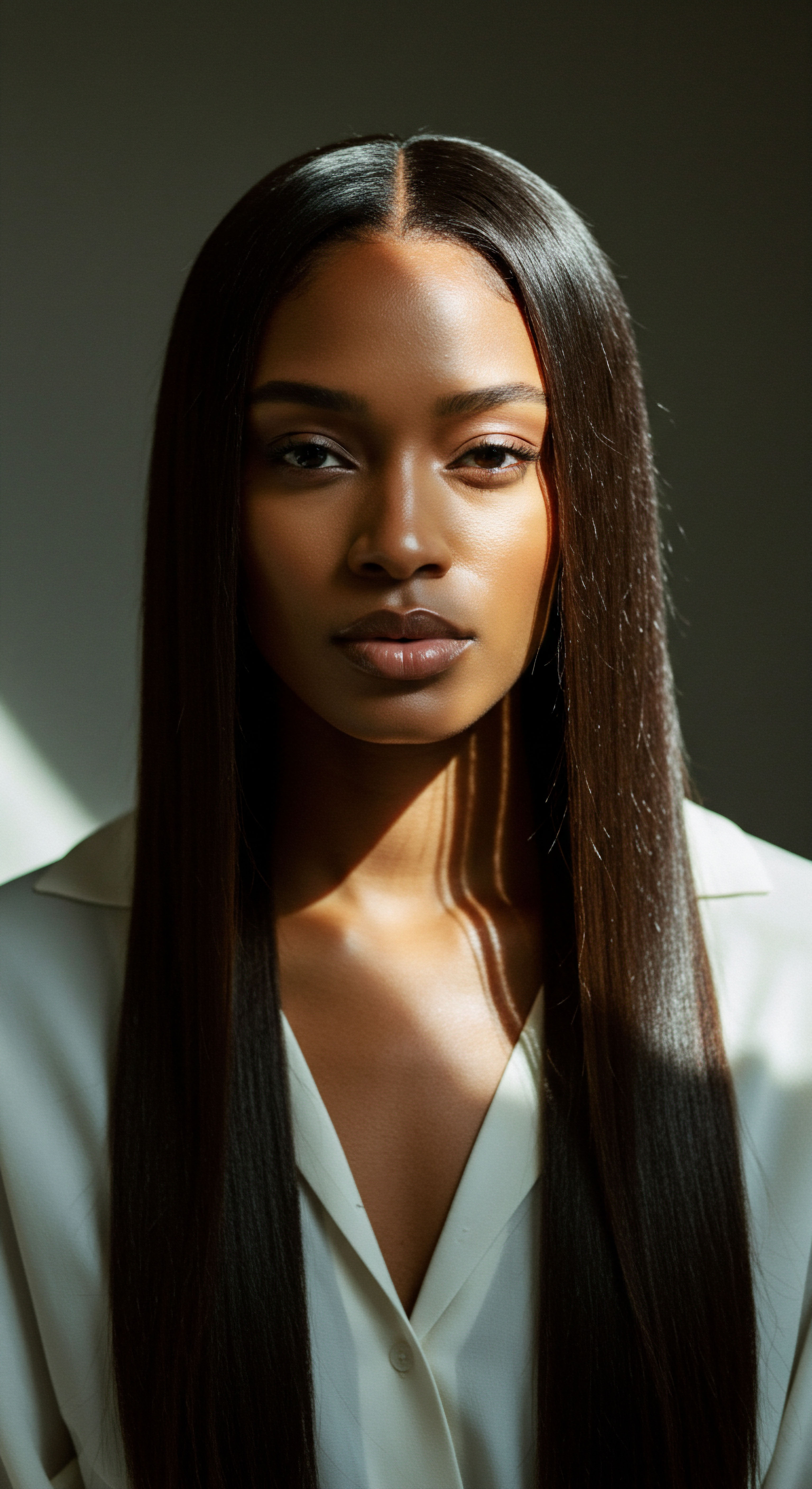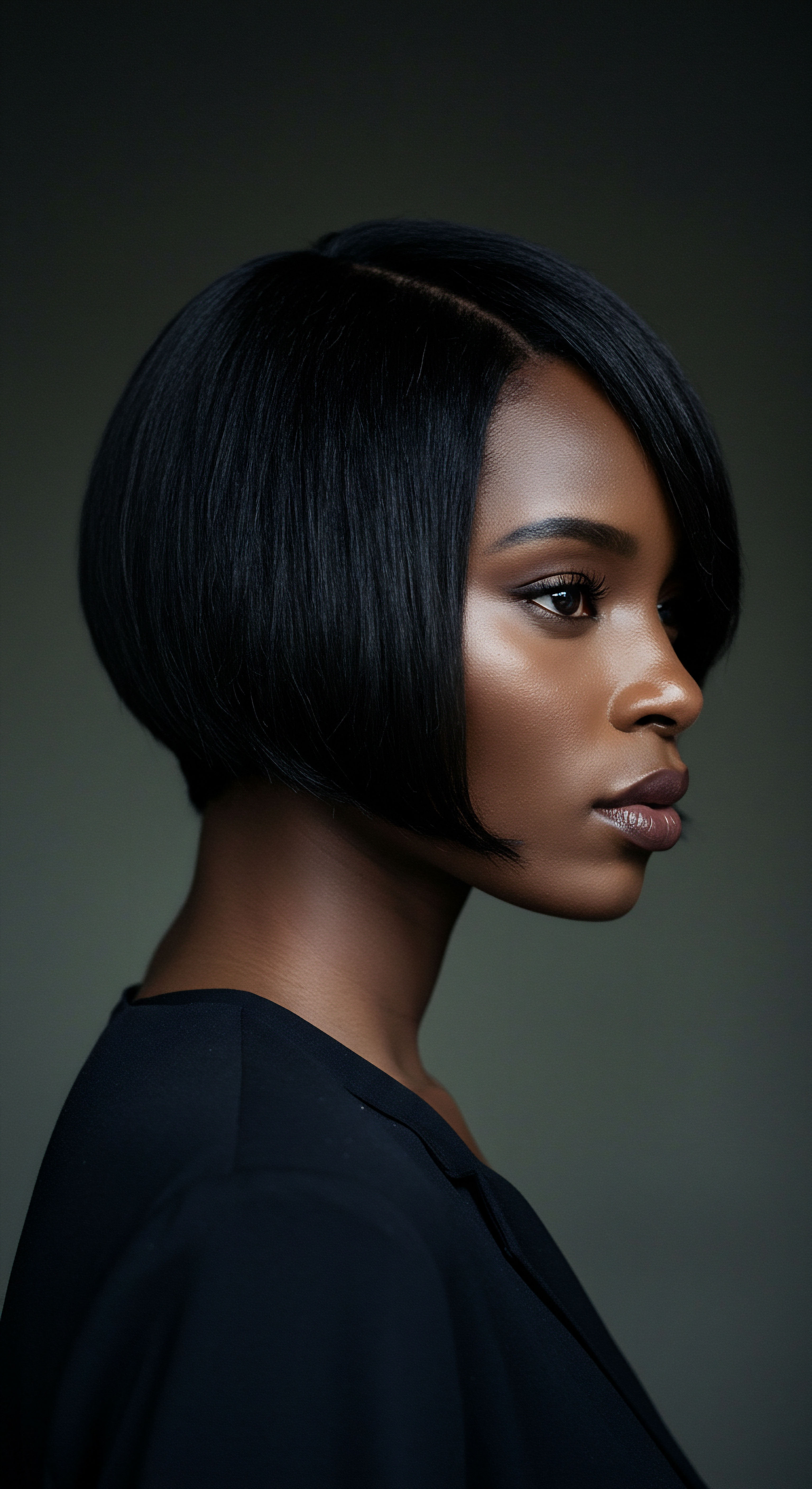
Roots
The quiet rustle of leaves in ancient groves, the whisper of ancestral knowledge carried on warm winds—these are the sensations that precede an exploration of traditional African hair care ingredients. For generations, long before the advent of modern laboratories and their myriad formulations, communities across the continent turned to the earth, the trees, and the wisdom passed down through hands and voices. This foundational understanding, rooted in observation and a deep reverence for nature, offers not merely remedies for strands, but a profound connection to heritage and self. It speaks to a time when care was a ceremony, a moment of presence, rather than a hurried application.
Consider the bounty of the land itself. From the arid savannas to the lush rainforests, a botanical treasury provided all that was needed to tend to the diverse textures of African hair. These ingredients were not chosen arbitrarily; their selection was a testament to generations of practical experience, a living science honed by direct interaction with the environment.
Each plant, each seed, each mineral, held a specific purpose, contributing to a holistic approach to hair health that extended beyond mere aesthetics. The benefits derived were often multifaceted, addressing not only the visible qualities of the hair but also the underlying condition of the scalp, and even the emotional well-being of the individual.

What Are The Core Botanical Contributions
The core botanical contributions to traditional African hair care stem from plants rich in emollients, humectants, and fortifying compounds. These natural resources provided the necessary elements to combat dryness, maintain suppleness, and shield delicate strands from environmental stressors. The wisdom of identifying and preparing these elements, often through labor-intensive processes, highlights a deep understanding of natural chemistry long before the term existed. This collective knowledge forms the bedrock of practices still relevant today, offering alternatives to synthetic compounds and their sometimes unpredictable interactions with textured hair.
- Shea Butter ❉ A rich, creamy substance extracted from the nuts of the African shea tree (Vitellaria paradoxa), revered for its exceptional moisturizing and conditioning capabilities. Its concentration of fatty acids and vitamins makes it a potent balm for dry, thirsty hair, providing a protective barrier against moisture loss.
- Baobab Oil ❉ Derived from the seeds of the majestic baobab tree (Adansonia digitata), this lightweight oil absorbs readily, delivering a wealth of omega fatty acids, particularly omega-3, -6, and -9. It aids in improving hair elasticity and promoting a healthy scalp environment.
- African Black Soap ❉ A cleansing agent made from the ash of plantain skins, cocoa pods, and shea tree bark, blended with oils. Its gentle yet effective cleansing action purifies the scalp without stripping natural oils, laying a clean foundation for subsequent care.
The traditional methods of preparing these ingredients often preserved their integrity, ensuring the maximum benefit was extracted. For instance, the painstaking process of rendering shea butter by hand, involving roasting, grinding, and kneading, was not merely a chore; it was a ritual that honored the plant and its gifts. This hands-on connection to the ingredients fostered a deeper appreciation for their role in personal care and well-being.

How Do Natural Humectants Benefit Textured Hair
Textured hair, by its very structure, often possesses a greater tendency towards dryness due to its coiled and curvilinear shape, which can make it challenging for natural oils to travel down the hair shaft. This inherent characteristic means humectants play a particularly vital role in its care. Traditional African hair care ingredients frequently offer natural humectant properties, drawing moisture from the air and holding it within the hair fiber. This natural moisture attraction is a cornerstone of maintaining suppleness and preventing brittleness.
For example, certain plant mucilages, such as those found in hibiscus or okra, when prepared as a slippery gel, act as natural humectants. They coat the hair, forming a pliable film that helps seal in hydration. This protective layer also aids in detangling, allowing combs and fingers to glide through coils with less friction, thereby reducing mechanical breakage. The efficacy of these natural humectants lies in their ability to work in harmony with the hair’s natural composition, providing sustained hydration without the heavy, often synthetic, feel of some commercial products.
Traditional African hair care ingredients offer a profound connection to heritage, providing multifaceted benefits that extend beyond aesthetics to scalp health and emotional well-being.
The consistent use of these hydrating elements contributes to the long-term health of textured hair, promoting its resilience and vibrancy. A well-hydrated hair strand is less prone to breakage, more elastic, and better able to withstand the daily manipulations and environmental exposures it encounters. This emphasis on moisture retention is a distinguishing characteristic of traditional African hair care philosophies, setting a standard for modern approaches to hair health.

Ritual
Stepping into the realm of traditional African hair care practices means acknowledging a profound shift from mere product application to the deliberate act of ritual. Here, the ingredients are not simply substances; they are components of a practiced cadence, a thoughtful sequence of movements and moments that speak to deeper understanding. This section explores how these ancient components are woven into routines, transforming daily upkeep into an act of mindful self-care and a testament to sustained health. The emphasis here is on the deliberate, gentle interaction with strands, allowing the inherent properties of each ingredient to truly work their wonders.
The true value of these traditional elements often becomes apparent when they are applied with intention and consistency. It is within these routines that the ingredients perform their most impactful work, delivering their benefits over time rather than in a single, fleeting application. The concept of hair as a living entity, deserving of patience and attentive care, is central to these rituals.

How Do Traditional Cleansing Agents Maintain Scalp Health
The foundation of healthy hair always begins with a healthy scalp. Traditional African cleansing agents, such as African black soap, approach this foundational step with a gentle yet effective touch. Unlike many harsh commercial shampoos that can strip the scalp of its protective sebum, these traditional cleansers work to purify without compromising the scalp’s delicate balance. The plant ashes within African black soap provide mild exfoliation, helping to dislodge dead skin cells and product build-up, which can impede healthy hair growth and lead to irritation.
The careful formulation of these traditional cleansers, often incorporating natural oils, ensures that while impurities are lifted, the scalp retains adequate moisture. This balance is particularly significant for textured hair, which benefits from a clean environment that is not overly dry or tight. A healthy scalp reduces itchiness, flakiness, and the potential for bacterial or fungal overgrowth, providing the optimal conditions for strands to emerge strong and vibrant. The consistent use of such gentle cleansers helps to regulate sebum production naturally, avoiding the cycle of over-drying followed by excessive oil production.

What Role Do Natural Oils Play in Hair Suppleness
Beyond simple moisturization, natural oils extracted from African botanicals play a pivotal role in promoting the suppleness and elasticity of hair. Oils like Argan Oil, sourced from the argan tree (Argania spinosa) in Morocco, or Marula Oil, from the marula tree (Sclerocarya birrea) in Southern Africa, are rich in antioxidants and fatty acids. These compounds penetrate the hair shaft, conditioning from within and smoothing the cuticle layer. A smooth cuticle reflects light, lending a natural sheen, and more importantly, helps to seal in moisture, reducing frizz and improving manageability.
Traditional ingredients, when applied with intention, transform daily hair upkeep into a mindful ritual, promoting sustained health and vibrancy.
The application of these oils, often through gentle massage or as part of a pre-shampoo treatment, allows their beneficial components to be fully absorbed. This regular lubrication of the hair fibers helps to prevent breakage, particularly at the points of natural curl patterns where hair is most vulnerable. The result is hair that feels soft to the touch, moves freely, and resists the stresses of styling and environmental exposure, showcasing its inherent strength and beauty.
| Ingredient Shea Butter |
| Botanical Origin Vitellaria paradoxa (Shea Tree) |
| Key Benefit for Hair Intense Moisturization, Scalp Conditioning |
| Ingredient Baobab Oil |
| Botanical Origin Adansonia digitata (Baobab Tree) |
| Key Benefit for Hair Elasticity, Omega Fatty Acid Nourishment |
| Ingredient African Black Soap |
| Botanical Origin Plantain Ash, Cocoa Pods, Shea Bark |
| Key Benefit for Hair Gentle Cleansing, Scalp Purification |
| Ingredient Argan Oil |
| Botanical Origin Argania spinosa (Argan Tree) |
| Key Benefit for Hair Cuticle Smoothing, Shine, Antioxidant Shield |
| Ingredient Marula Oil |
| Botanical Origin Sclerocarya birrea (Marula Tree) |
| Key Benefit for Hair Deep Conditioning, Hair Fiber Protection |
| Ingredient These ingredients represent a fraction of the diverse botanical wealth used in traditional African hair care practices. |

Relay
To truly comprehend the benefits of traditional African hair care ingredients, one must transcend a superficial glance and delve into the intricate interplay of cultural practice, scientific understanding, and the lived experiences of generations. This section moves beyond basic descriptions, offering a sophisticated exploration of how these ancestral methods not only preserve hair health but also contribute to a holistic sense of well-being and cultural continuity. The discussion here seeks to bridge ancient wisdom with contemporary research, offering a multi-dimensional view that honors both tradition and modern inquiry.
The efficacy of these ingredients is not merely anecdotal; a growing body of research, though still nascent in some areas, begins to provide scientific grounding for practices long understood by communities. This deeper examination reveals the complex biochemical properties of these natural compounds and how their traditional application methods amplify their beneficial effects, moving beyond simple cause and effect to a more nuanced understanding of hair biology and cultural heritage.

Do Traditional Hair Care Practices Offer Superior Tensile Strength
The pursuit of length and strength in textured hair is a common aspiration, and traditional African practices often appear to deliver on this promise. One compelling example comes from the women of Chad, who for generations have utilized Chebe Powder, a mixture of various plants including croton gratissimus, along with oils and resins. Anecdotal accounts often attribute the remarkable length of their hair directly to the powder itself. However, a closer examination, particularly through ethnographic observations and emerging cosmetic science, suggests a more complex mechanism at play.
A study exploring the properties of Chebe powder, while not definitively establishing a direct increase in hair tensile strength from the powder alone, highlighted the significance of its traditional application. The Chadian practice involves moistening the hair, applying a mixture of Chebe powder and oil, and then braiding the hair. This method effectively creates a protective coating around the hair strands, sealing in moisture and significantly reducing mechanical friction and breakage during daily activities and styling. Research by M.
L. G. L. F.
Kaboré, et al. in the Journal of Cosmetic Science (2021), suggested that while the powder itself might contribute some conditioning elements, the sustained moisture retention and reduced manipulation inherent in the traditional application method are the primary drivers of reduced breakage and apparent length retention. This shifts the focus from a “magic ingredient” to the profound wisdom embedded in the ritual itself, underscoring that the benefit arises from the ingredient’s interaction with a carefully maintained practice. This nuanced understanding challenges the simplistic notion that an ingredient alone is the sole determinant of hair health, instead pointing to the interconnectedness of component and custom.
The benefits of traditional African hair care ingredients stem from a sophisticated interplay of their biochemical properties and the deliberate application methods, creating a holistic system for hair health.
This example underscores a broader principle ❉ the benefits of traditional African hair care ingredients are often maximized not just by their inherent chemical properties, but by the thoughtful, consistent application methods that have been refined over centuries. These practices minimize stress on the hair, allowing it to grow and retain its length without constant external damage.

How Do Cultural Contexts Shape Hair Care Efficacy
The effectiveness of traditional African hair care ingredients extends beyond their biochemical actions; it is deeply embedded within cultural contexts that shape their use, perception, and ultimately, their efficacy. Hair in many African societies holds immense cultural and spiritual significance, often serving as a marker of identity, status, and beauty. This cultural valuing of hair elevates its care from a mundane task to a meaningful ritual, fostering consistency and respect for the process.
For instance, the communal aspect of hair braiding and care in many African communities creates a supportive environment where knowledge is shared, and practices are reinforced. This collective approach ensures that traditional methods are passed down accurately and that individuals receive assistance in maintaining their hair. The psychological benefits derived from these communal rituals—a sense of belonging, self-acceptance, and pride in one’s heritage—can indirectly contribute to hair health by reducing stress and promoting consistent self-care. When hair care is tied to identity and community, individuals are more likely to invest time and effort into routines that support hair health.
Moreover, the long-term use of natural ingredients, often grown or harvested locally, minimizes exposure to harsh chemicals found in many commercial products. Over time, this consistent gentleness can lead to healthier hair and scalp conditions, preventing the cumulative damage that synthetic ingredients or aggressive styling practices might inflict. The wisdom inherent in these traditional approaches often prioritizes preservation and natural strength over quick fixes, leading to sustained, genuine benefits.
Consider the broader ecological implications. Sourcing ingredients locally and relying on sustainable harvesting practices, as was traditionally done, aligns with a philosophy of living in harmony with the environment. This circular approach not only secures the supply of beneficial ingredients but also supports biodiversity and ecological balance, contributing to a sustainable model of beauty care that stands in stark contrast to many industrial practices. The deep understanding of the local flora, often cultivated through generations of ethnobotanical knowledge, represents a profound connection to the land and its offerings.

Reflection
As we draw our exploration to a close, a quiet realization settles ❉ the benefits of traditional African hair care ingredients are not merely a list of properties, but rather a profound dialogue between nature, heritage, and self. It is a dialogue that speaks of patience, of knowing one’s strands intimately, and of drawing sustenance from the earth with a gentle hand. The wisdom embedded in these practices transcends fleeting trends, offering a timeless approach to care that honors both the science of the strand and the spirit of the individual. This enduring legacy reminds us that true radiance often lies in returning to the simple, potent gifts that have always been present.

References
- Kaboré, M. L. G. L. F. et al. (2021). Evaluation of the Effect of Chebe Powder on Hair Fiber Properties. Journal of Cosmetic Science, 72(4), 275-284.
- Akihisa, S. A. et al. (2010). Triterpene Alcohols and Fatty Acids of Shea Butter from Vitellaria paradoxa. Journal of Oleo Science, 59(12), 651-657.
- Singh, P. K. et al. (2018). A Review on Natural Hair Care Ingredients from African Plants. International Journal of Pharmacy and Pharmaceutical Sciences, 10(1), 1-8.
- Ejiofor, C. E. (2015). Ethnobotanical Survey of Medicinal Plants Used for Hair Care in Nigeria. Journal of Medicinal Plants Research, 9(35), 906-913.
- Kukula, M. & Musyoka, M. (2019). Traditional African Hair Practices ❉ A Review of Historical and Cultural Significance. Journal of Black Studies, 50(6), 579-595.